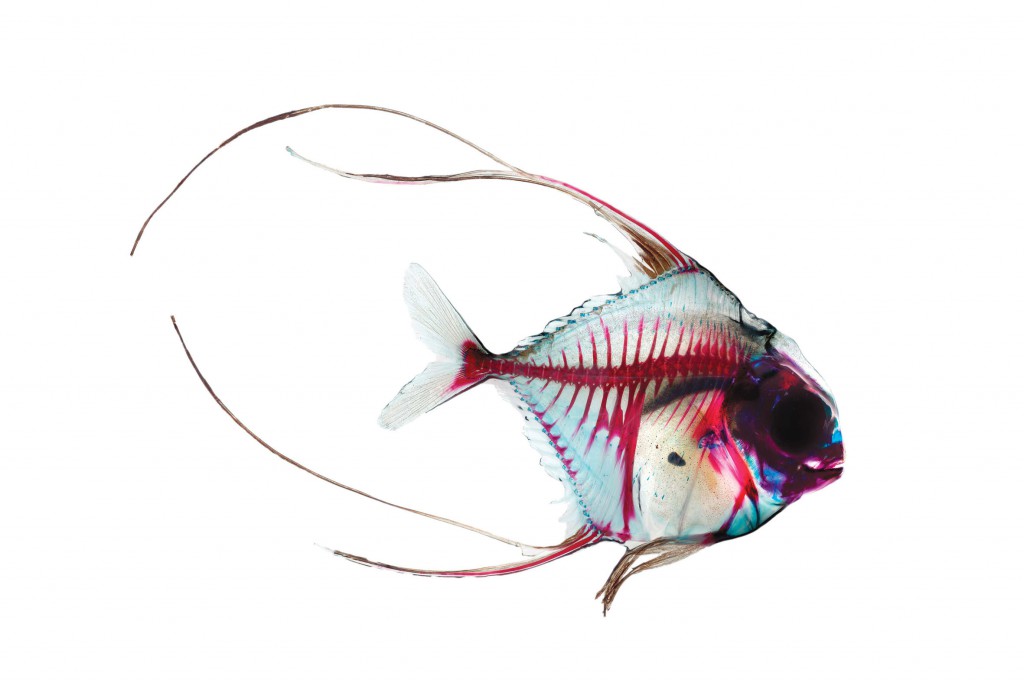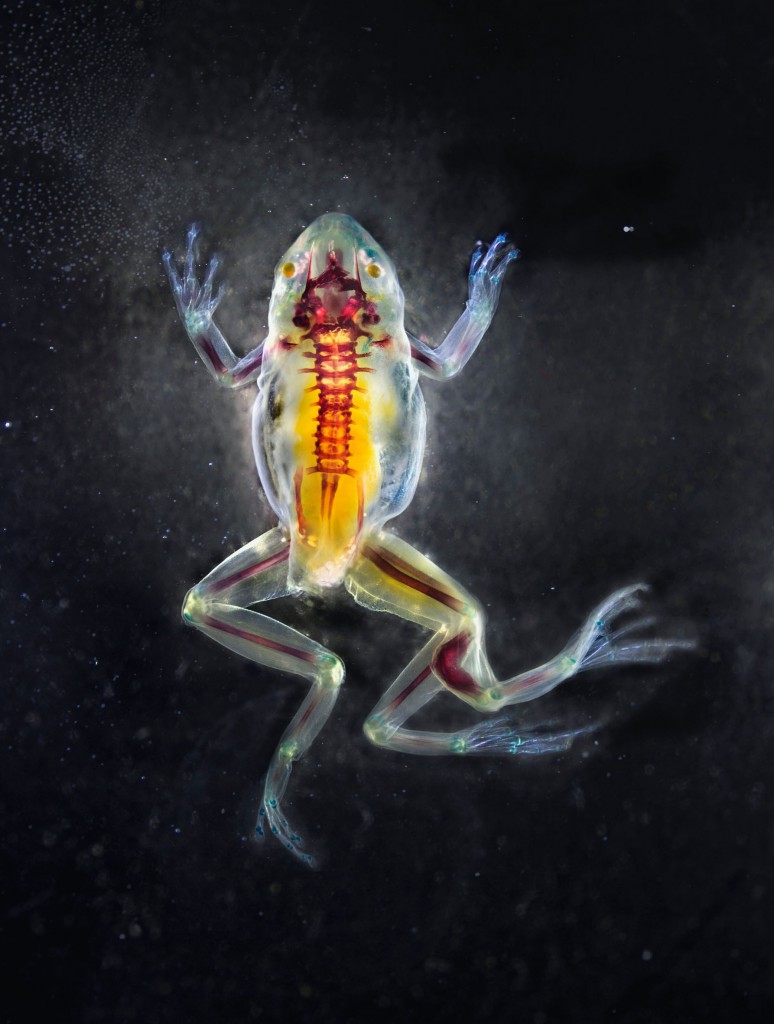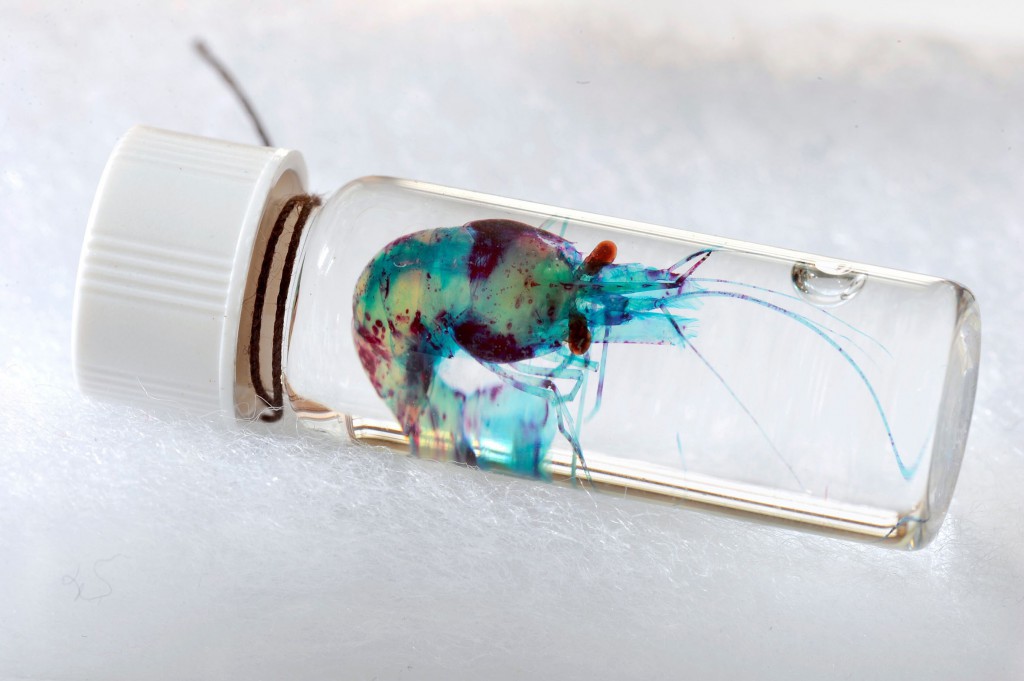It is this looming, possibly catastrophic change that Brandon Ballengée — an artist, biologist and environmental activist — takes as the subject matter for his art.
The exhibition NatureCultures, shown at Alfred Ehrhardt Stiftung, explores the interwoven fabric of both the human and nonhuman in the 21st century. The exhibition title refers to a term coined by the American scholar Donna Haraway, which seeks to overcome the unproductive dichotomy of nature and culture. The side effects of human technology intrude into every environment, altering the balance, and even the make-up of what we once called nature. While ecological disaster repeatedly threatens, there is a surprising resiliency in the myriad of life forms on this planet. The exhibition presents three artists who explore a realm between science and artistic research as well as between natural and cultural forms of inquiry.

© Brandon Ballengée / Courtesy Ronald Feldman Fine Arts, New York, NY
Dear Brandon, your work is based at the crossroads of art and science. What is it that interests you about it and where do you feel are your roots?
Art and science are both ways to understand the world around us and within us—through the sciences, through this observational lens that is methodologically based, and through the arts, which are much more emotive and coming from a different place where you are able to describe complex sensations that can’t be described by science.
When I am doing the science, when I’m doing the lab work or the field work, I start thinking about art projects. When I’m having these experiences, like literally holding a particular frog with a deformity or fish or animals in these ecosystems, my brain starts thinking about art and visuals. I want to create things to describe this experience, to give visual form to this experience. And when I’m making the art, my brain starts thinking in other directions, like what if I do this experiment because it may show us this? My art practice and science work really inform and inspire each other, so it’s literally cross-pollination, where I couldn’t do one without the other.
I’m quite interested in that kind of optical sensation that occurs when you see an artwork and it touches you or moves you or captivates you, engages you. It’s tremendously powerful. I had this experience growing up in central Ohio, for the first time, when I was 12 or something, going to the Columbus Art Museum and seeing paintings by Robert Motherwell, and Franz Kline, and Willem de Kooning. I just remember sitting in front of this Motherwell and just being completely blown away. It was so visually powerful that it completely rearranged my perceptions. Then I became a terrible teenage abstract expressionist. It was horrible. But I think that power is a really important means to reach people in a way that’s not easily quantifiable.

© Brandon Ballengée / Courtesy Ronald Feldman Fine Arts, New York, NY
Some of your works on amphibians will be exhibited in the exhibition NatureCultures at Alfred Ehrhardt Stiftung Berlin which has been curated by Christian de Lutz and Regine Rapp. How did you get involved with amphibians?
I had a lab in my parents’ basement and I had an art studio in our barn…. I was one of those kids who was constantly out catching fish and going in the stream and collecting salamanders and frogs and turtles, and then I’d bring them into the lab, keep them for a while, draw them, and then let them go. As an adult, my artwork and scientific research are still very much in sync. Even as I document mutation and extinction in the amphibian world in the lab, in the studio I create erasure works (made by manually excising elements from existing works of art) and installations that add emotional resonance to my data.
As a biologist, the reason I got into amphibians in the first place is because of this global crisis that is happening with their populations. I wanted to be a fish guy but I ended up being a frog guy because there’s just so much to figure out. Upwards of 40 percent, maybe even 43 percent, of the known species are considered in decline, have declined, or are already extinct! It’s a kind of crisis that’s occurred within my lifetime, within 40 years. The first big papers about amphibian extinction started to come out in 1989 and then in the early ’90s. They were thinking it was maybe 20, 25, 28 percent decline rate and each year getting worse. It’s not only tragic from a species level, but it’s horrifying because they’ve been here a really long time and they’ve lived through several mass extinction events.
You get this sense of void where they are disappearing, and there’s very little global effort being done to stop it nor even slow it down. I respond to these issues through a body of work I refer to as Malamp. With the Malamp works I try to give individual presence, visually, to the terminally deformed frogs I have found at locations around the world. This takes the form of unique printed portraits in Malamp: Reliquaries and sculpturally in the installation Styx whereby I exhibit the actual specimens on specially designed floor-standing light-boxes.

© Brandon Ballengée / Courtesy Ronald Feldman Fine Arts, New York, NY
You’re also an eco-activist. Which have been some of your most recent actions?
I teach biology and ecology, pure science courses, in an art school here in New York City—the School of Visual Arts—and the classes are completely full. Young artists are really interested in these ideas. We are becoming much more environmentally aware as a global culture.
Increasingly we are starting to see more and more exhibitions internationally with environmentalist art or ecological art. It’s a growing movement. Certainly with all of the new knowledge that’s being sent out to society at large, many artists are dealing with issues such as climate change. These issues are so pertinent and critical that more and more artists are doing it. Now we see more and more museums and galleries and universities offering more exhibitions of this kind of work and more programming that involves this kind of work, like workshops and courses in combined art and science.
So you have to do the research to learn when the species went extinct and then try to find depictions, because for a lot of the species there aren’t any. They just were there, and then they were gone. And some of the time they are only depicted in graphic forms, in scientific papers, so I utilize those now too. Initially I was working just with prints by John James Audubon, who I always considered such a hero, such an interesting and important artist and scientist and educator. I started with Audubon, and then I expanded out to 60 or 70 different artist-scientists as the body of work has continued with prints from the 1600s to today. Right now, I have mostly been focusing on the Americas, North America, South America, the Islands, and have included Hawaii. Over a decade I have been collecting the prints, a lot from Europe while I was working there. So that was a whole other side to this project of trying to find a depiction, and then sourcing the prints, and then financing the project.
It’s an overused analogy, but the idea of just asking a question through a different lens is so important. I find when I’m working with the public on what I call “eco-actions,” which are citizen-science field trips or participatory biology field trips where I’m asking people to come and help me do the fieldwork, they are making observations that are completely novel. They are asking these questions so out of the box that it makes me think about things differently. I can see firsthand the creative benefit for that from a scientific standpoint and from years of working with other scientists within this realm of art and science. It’s common knowledge that people do benefit from this kind of cross-pollination and get inspired. Certainly artists are becoming inspired and influenced by science, and vice versa. Increasingly we are seeing laboratories and research facilities that want to invite artists because it’s just going to be adding a new layer of creativity. Likewise, environmental organizations are increasingly reaching out to artists that have creative input. I think that’s really exciting.
Thank you!
(This is an excerpt from an interview in 2015. You will find the whole interview held by Paulette Beete here: https://www.arts.gov/art-works/2015/art-and-science-talk-artist-biologist-brandon-balleng%C3%A9e)
ALFRED EHRHARDT STIFTUNG | Auguststr. 75 | 10117 Berlin | +49 (0)30 200953-33 | Opening hours: Tue-Sun 11 – 6 pm. Thu 11 – 9 pm. Admission free | info@alfred-ehrhardt-stiftung.de | www.alfred-ehrhardt-stiftung.de